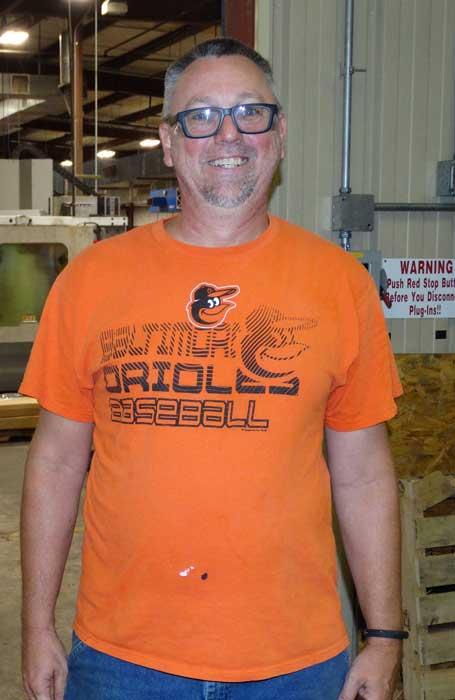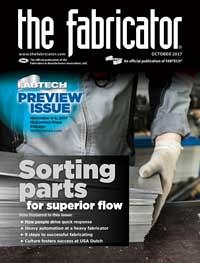Senior Editor
- FMA
- The Fabricator
- FABTECH
- Canadian Metalworking
Categories
- Additive Manufacturing
- Aluminum Welding
- Arc Welding
- Assembly and Joining
- Automation and Robotics
- Bending and Forming
- Consumables
- Cutting and Weld Prep
- Electric Vehicles
- En Español
- Finishing
- Hydroforming
- Laser Cutting
- Laser Welding
- Machining
- Manufacturing Software
- Materials Handling
- Metals/Materials
- Oxyfuel Cutting
- Plasma Cutting
- Power Tools
- Punching and Other Holemaking
- Roll Forming
- Safety
- Sawing
- Shearing
- Shop Management
- Testing and Measuring
- Tube and Pipe Fabrication
- Tube and Pipe Production
- Waterjet Cutting
Industry Directory
Webcasts
Podcasts
FAB 40
Advertise
Subscribe
Account Login
Search
How trust leads to success in custom fabrication
How culture drives growth at North Carolina custom fabricator
- By Tim Heston
- October 11, 2017
- Article
- Shop Management
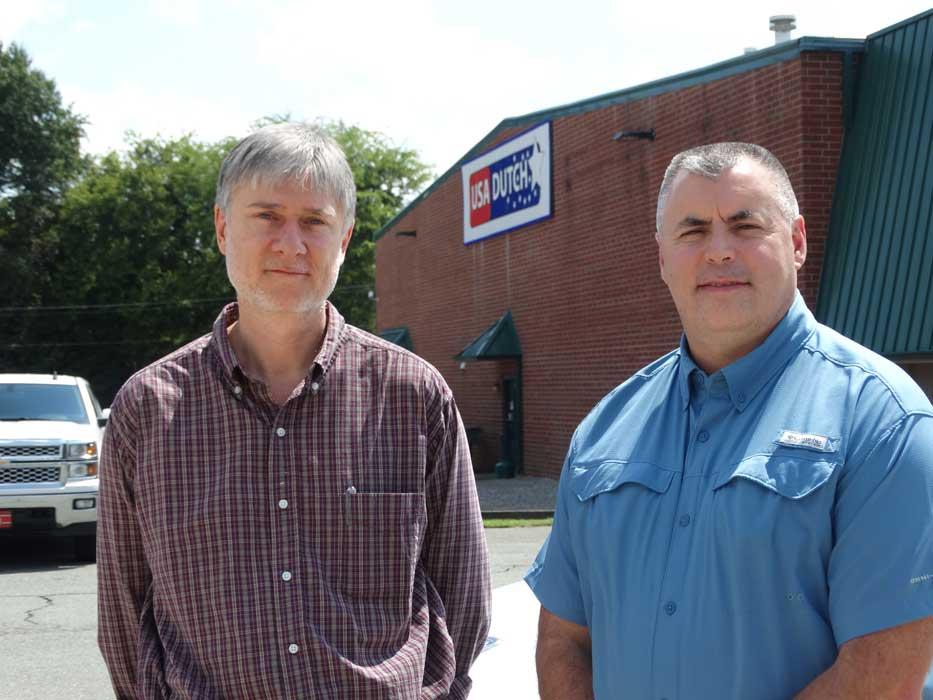
President Ronald Keizer (left) and Operations Manager Jeff Albaugh stand in front of what used to be AllFab Solutions’ main facility. USA Dutch acquired AllFab in 2015, and since then managers and employees have worked to spread the USA Dutch culture throughout the organization.
As a shop lead at USA Dutch, a custom metal fabricator in Graham, N.C., Gary McCormick is an idea man. He continually dreams up a new way to fixture this or cut that. When the thought comes to him—walking his small dogs, running errands, before bed—he jots it down and thinks about putting the idea into action. It’s going to be a good day.
If you walk the shop floor, you may catch Eric Kent singing a country tune under his welding helmet. Hear that, and you know it’s a good day.
Jerry Lynch, press brake operator, talks to a colleague operating the punch press. Could he nest the parts so that the punched and deburred side of holes are on the inside of an enclosure? His co-worker nods and says, “No problem.” It’s going to be another good day.
Quality Inspector Cheyenne Edwards likes math. “Doing a lot of math throughout the day is great,” she said. “And it’s fun to understand why we make the parts the way we make them. I love the fact that I get to know a little bit about every process we do here.” When she arrives at work, she knows she’ll be looking at blueprints, talking with employees in different departments, and working to solve problems. She knows it will be a good day.
These brief conversations have an undertone of relaxed yet still engaged enjoyment. People seem to like their jobs, their co-workers, and their employer—no small feat, considering that less than two years ago USA Dutch purchased a competing fabricator that happened to be a larger shop.
The culture seems healthy and genuine. No one seems to be paying lip service. But what exactly makes a good company culture? As President Ronald Keizer put it, “It starts with trust.”
The Culture Conundrum
During the final session of a 2014 continuous improvement seminar called LeanFab, hosted by the Fabricators & Manufacturers Association (FMA), one shop owner asked a question: “Isn’t it really all about culture?”
Conference speakers talked about the importance of complete documentation, standard procedures, visual management and 5S, limiting work-in-process inventory, quick changeover, reducing lot sizes, pull-system part flow, overall equipment effectiveness and total productive maintenance, and more. Seminar attendees and speakers agreed that, yes, improvement tools are vital to compete in modern manufacturing. So is modern technology. But underlying it all must be a culture of trust.
Building such a culture is difficult in any business, and perhaps even more challenging in modern manufacturing. Culture issues can stem from a command-and-control atmosphere, where no one trusts anyone, and where owners and managers feel that business would be a lot less stressful if they didn’t have to deal with people. Even if managers have the best interest of employees at heart, they can have a tough time getting people to buy in to change. The history of job loss in manufacturing is difficult to ignore. Change is difficult when people are afraid.
Judging by USA Dutch’s financial results, paying attention to company culture may be good for business. Keizer has participated in FMA’s annual “Financial Ratios & Operational Benchmarking” surveys, and in many years he said the company had financial metrics, including EBITDA margin, at the very top of reported results. “We know what a profitable shop looks like,” he said.
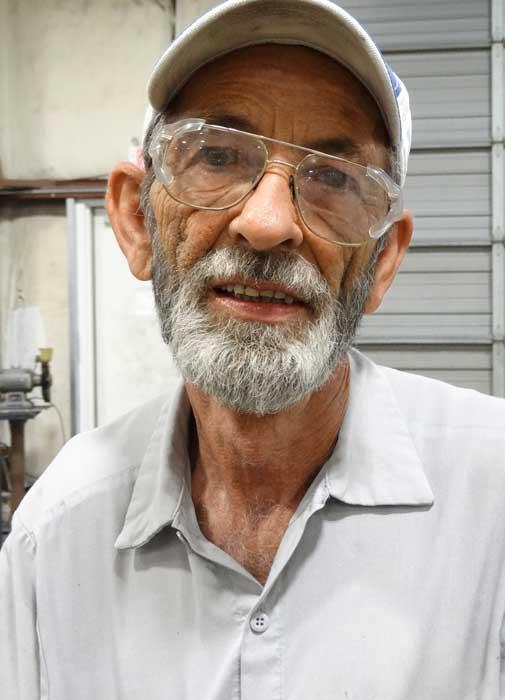
I’m always thinking about what I can do to help the company and the processes we do here. Sometimes I get up in the night and jot a few ideas down, maybe an idea about a fixture to make somebody’s job faster or simpler. I think about work just about all the time. But if you really enjoy what you’re doing, it makes a big difference. — Gary McCormick, shop lead
The fabricator accomplished this without having a high level of automation. There’s no robotic welding, and the press brakes don’t have automatic tool changes. When it comes to laser cutting and punching, the shop has no material handling towers or flexible manufacturing systems.
Keizer was quick to point out that this doesn’t mean that investing in automation isn’t good for other fabricators with different customer mixes. He just hasn’t seen the need thus far for his business.
“I don’t want to automate for the sake of automation,” Keizer said.
Operations Manager Jeff Albaugh added that he sees the shop making future machine purchases mainly because of the skilled labor shortage, made especially acute by the area’s low unemployment rate. This could include some new press brake technology. But like Keizer, Albaugh views automation as something that will allow employees to produce more and respond to customers quickly. It’s not about addressing a personnel problem or replacing people with automation.
A Turning Point
USA Dutch is a family business, launched by Ronald’s mother, Rita Keizer (who still does the accounting), and her second husband out of a shed in the backyard in 1987. Rita is Dutch, her second husband is American, hence the company name. Ronald Keizer joined the company in 1995.
In the 1990s the shop received more than 80 percent of its revenue from just one customer. “We worked very hard to diversify, and just in time, too,” Keizer said. “When the recession hit in 2001, our sales went from $2.5 million down to $1 million. It was rough, but we made it.”
The company grew steadily until the next downturn in 2009, when business was hit again and sales dropped by 35 percent. The company laid off six people—a big deal for a 24-person shop—but by 2010 the company rehired all but one as work started to come back in the door.
2010 was a turning point. “It was then I realized that I wanted to run the business with the hope of never having to lay off again,” Keizer said.
To that end, teams wrote a company credo:
- We are dedicated to serving our customers.
- We conduct ourselves with integrity.
- We take pride in everything we do.
- We are respectful of others.
- We believe in working together.
- We believe in a positive mindset.
- We believe in the power of relationships.
Using the credo’s guiding principles, team members then developed a mission statement: “To enjoy becoming a $5 million company and laying the groundwork for expansion.”
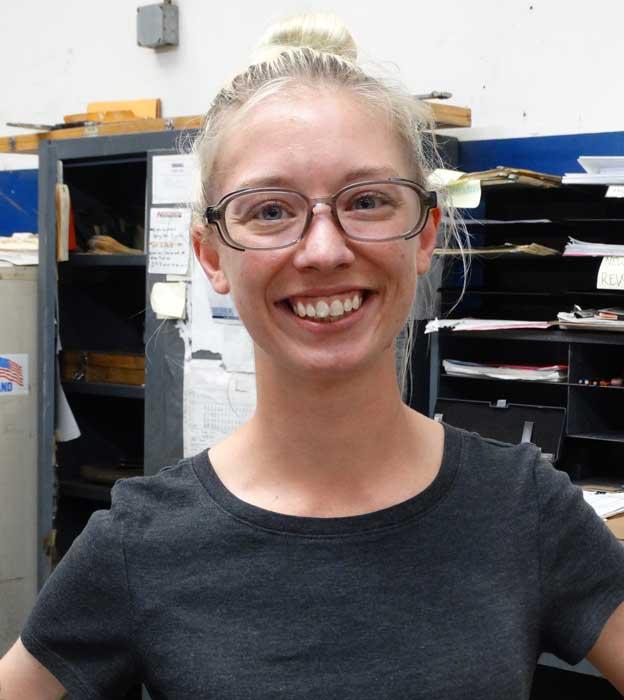
Doing a lot of math throughout the day is great. And it’s fun to understand why we make the parts the way we make them. I love the fact that I get to know a little bit about every process we do here. – Cheyenne Edwards, quality assurance
Keizer is quick to point out that he doesn’t know if this exercise affected the company’s subsequent growth, but grow it did. By 2015 the firm was in a strong enough position financially to purchase a larger local competitor, AllFab Solutions. Overnight the company grew from 26 employees to more than 60.
Spreading Good Culture
Since the acquisition, USA Dutch moved from its facility in Efland, N.C., to AllFab Solutions’ location in Graham, between Greensboro and Durham. AllFab had two facilities adjacent to each other, the main plant and one building dedicated to overflow work. USA Dutch moved into that overflow plant, while most AllFab employees remained in their existing plant next door.
The two operations are still in separate buildings, and that’s by design. Employees in each plant know how to process certain parts for certain core customers. Though managers are working to merge the two operations, they aren’t rushing it. They’re first working to spread a culture of trust.
During one of the first meetings with AllFab employees after the acquisition, Keizer asked them to imagine a box holding the company’s profits, supported by three legs of a stool: sales growth, cost reduction, and efficiency. The larger the box grows, the more sustainable the company will be through good times and bad. But for that box to grow and stay balanced on the stool, all three legs need to grow as well.
Annual revenue has now surpassed $5 million, and with the addition of AllFab, the company has a platform for future growth. First mission accomplished. Now employees are gathering to discuss a new mission. Seventeen employees, including top managers, supervisors, and front-line personnel, from various departments will meet. Keizer said he hopes to have a new mission nailed down by the end of the year.
What will that mission be, exactly? Keizer doesn’t know, and that’s really the point. The mission isn’t handed down from on high. Employees guide the effort, and they own the result.
Bottom Up
Sit with Keizer and Albaugh, and you realize that both pause before answering a question or adding a comment. They don’t just wait to talk. They listen.
Keizer makes it a point to meet with each employee individually. He takes everyone out to lunch for their birthday and asks about their job and who helps whom on the floor. After having so many of these conversations, he has a good idea about who’s really respected in the organization.
He and other managers also ask what would make their workday easier. Within reason, they will spend time and money to give them the right tools to make it happen.
Managers also listen to employees who may want to move up or to different areas of the plant. Edwards, for instance, used to weld. She told her supervisor that she would like to apply for a quality manager position. Company leaders said she didn’t have the experience for that position, but they noticed her interest, and soon gave her a job as a quality inspector.
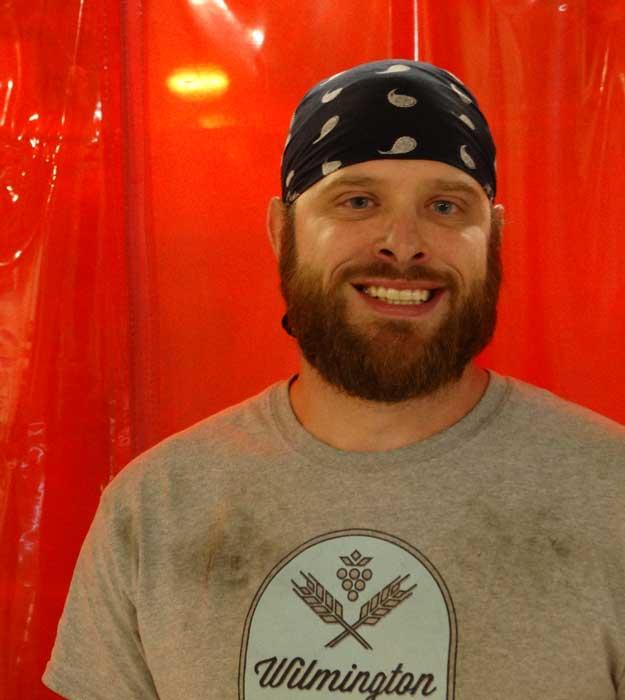
I just enjoy coming to work here. The people are nice to work with. I can sit back here and listen to the radio. I sing songs, and I’m sure everyone hears me singing throughout the day. I just have a good time. —Eric Kent, welder
“It’s been so nice to work somewhere where people can move up within the company,” she said, “and the company trains them well enough so that they’re not just on their own.”
Some large changes do come from the top. For instance, managers listen to employees about how they feel people and processes from AllFab and USA Dutch should be integrated, but the ultimate integration strategy is coming from the top. But for the most part, USA Dutch is the opposite of a command-and-control shop environment. Change happens from the bottom up.
Keizer and Albaugh both have a strong sense of empathy and humility. They don’t hesitate to say, “I don’t know.” Will their management approach work elsewhere? Is it the best way to run a fabricator? Keizer and Albaugh really aren’t sure. All they know is that it seems to have worked for them. They do know one thing for sure: They’re happy running the company the way they do.
Quality Assurance Inspector Chris Brown summed it up this way: “We have good communication here, from the top all the way down. So many people are helpful. They give their knowledge to others to help them grow. We have fun. I like to talk. I like to smile. I like to laugh. And we take pride in what we do.”
USA Dutch Inc., 336-227-8600, www.usadutchinc.com
About the Author

Tim Heston
2135 Point Blvd
Elgin, IL 60123
815-381-1314
Tim Heston, The Fabricator's senior editor, has covered the metal fabrication industry since 1998, starting his career at the American Welding Society's Welding Journal. Since then he has covered the full range of metal fabrication processes, from stamping, bending, and cutting to grinding and polishing. He joined The Fabricator's staff in October 2007.
subscribe now

The Fabricator is North America's leading magazine for the metal forming and fabricating industry. The magazine delivers the news, technical articles, and case histories that enable fabricators to do their jobs more efficiently. The Fabricator has served the industry since 1970.
start your free subscription- Stay connected from anywhere

Easily access valuable industry resources now with full access to the digital edition of The Fabricator.

Easily access valuable industry resources now with full access to the digital edition of The Welder.

Easily access valuable industry resources now with full access to the digital edition of The Tube and Pipe Journal.
- Podcasting
- Podcast:
- The Fabricator Podcast
- Published:
- 04/16/2024
- Running Time:
- 63:29
In this episode of The Fabricator Podcast, Caleb Chamberlain, co-founder and CEO of OSH Cut, discusses his company’s...
- Trending Articles
Capturing, recording equipment inspection data for FMEA

Tips for creating sheet metal tubes with perforations

Are two heads better than one in fiber laser cutting?

Supporting the metal fabricating industry through FMA

Omco Solar opens second Alabama manufacturing facility

- Industry Events
16th Annual Safety Conference
- April 30 - May 1, 2024
- Elgin,
Pipe and Tube Conference
- May 21 - 22, 2024
- Omaha, NE
World-Class Roll Forming Workshop
- June 5 - 6, 2024
- Louisville, KY
Advanced Laser Application Workshop
- June 25 - 27, 2024
- Novi, MI
























